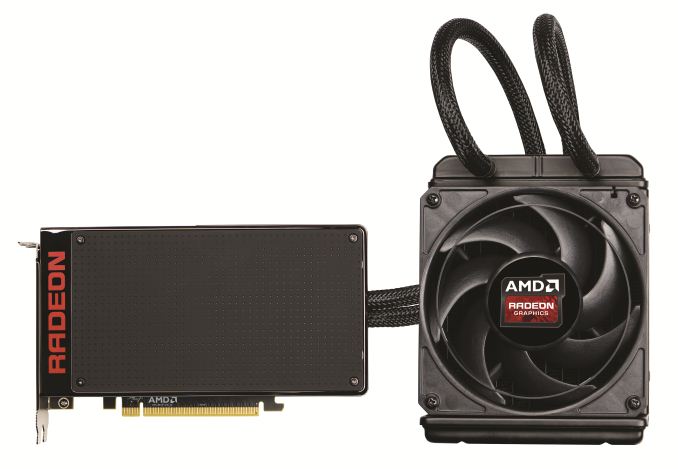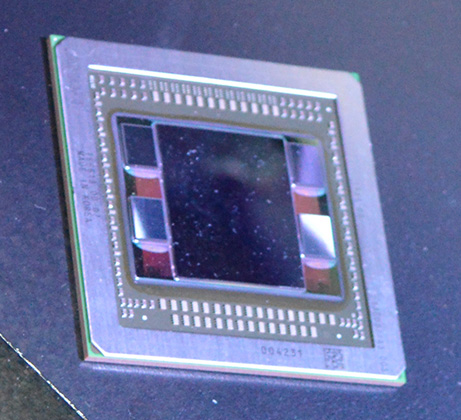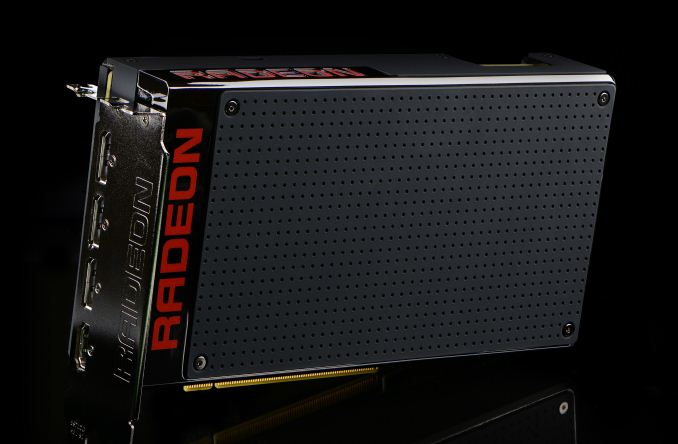The AMD Radeon R9 Fury X Review: Aiming For the Top
by Ryan Smith on July 2, 2015 11:15 AM EST
Almost 7 years ago to this day, AMD formally announced their “small die strategy.” Embarked upon in the aftermath of the company’s struggles with the Radeon HD 2900 XT, AMD opted against continuing to try beat NVIDIA at their own game. Rather than chase NVIDIA to absurd die sizes and the risks that come with it, the company would focus on smaller GPUs for the larger sub-$300 market. Meanwhile to compete in the high-end markets, AMD would instead turn to multi-GPU technology – CrossFire – to offer even better performance at a total cost competitive with NVIDIA’s flagship cards.
AMD’s early efforts were highly successful; though they couldn’t take the crown from NVIDIA, products like the Radeon HD 4870 and Radeon HD 5870 were massive spoilers, offering a great deal of NVIDIA’s flagship performance with smaller GPUs, manufactured at a lower cost, and drawing less power. Officially the small die strategy was put to rest earlier this decade, however even informally this strategy has continued to guide AMD GPU designs for quite some time. At 438mm2, Hawaii was AMD’s largest die as of 2013, still more than 100mm2 smaller than NVIDIA’s flagship GK110.

AMD's 2013 Flagship: Radeon R9 290X, Powered By Hawaii
Catching up to the present, this month marks an important occasion for AMD with the launch of their new flagship GPU, Fiji, and the flagship video card based on it, the Radeon R9 Fury X. For AMD the launch of Fiji is not just another high-end GPU launch (their 3rd on the 28nm process), but it marks a significant shift for the company. Fiji is first and foremost a performance play, but it’s also new memory technology, new power optimization technologies, and more. In short it may be the last of the 28nm GPUs, but boy if it isn’t among the most important.
With the recent launch of the Fiji GPU I bring up the small die strategy not just because Fiji is anything but small – AMD has gone right to the reticle limit – but because it highlights how the GPU market has changed in the last seven years and how AMD has needed to respond. Since 2008 NVIDIA has continued to push big dies, but they’ve gotten smarter about it as well, producing increasingly efficient GPUs that have made it harder for a scrappy AMD to undercut NVIDIA. At the same time alternate frame rendering, the cornerstone of CrossFire and SLI, has become increasingly problematic as rendering techniques get less and less AFR-friendly, making dual GPU cards less viable than they once were. And finally, on the business side of matters, AMD’s market share of discrete GPUs is lower than it has been in over a decade, with AMD’s GPU plus APU sales now being estimated as being below just NVIDIA’s GPU sales.
Which is not to say I’m looking to paint a poor picture of the company – AMD Is nothing if not the perennial underdog who constantly manages to surprise us with what they can do with less – but this context is important in understanding why AMD is where they stand today, and why Fiji is in many ways such a monumental GPU for the company. The small die strategy is truly dead, and now AMD is gunning for NVIDIA’s flagship with the biggest, gamiest GPU they could possibly make. The goal? To recapture the performance crown that has been in NVIDIA’s hands for far too long, and to offer a flagship card of their own that doesn’t play second-fiddle to NVIDIA’s.
To get there AMD needs to face down several challenges. There is no getting around the fact that NVIDIA’s Maxwell 2 GPUs are very well done, very performant, and very efficient, and that between GM204 and GM200 AMD has their work cut out for them. Performance, power consumption, form factors; these all matter, and these are all issues that AMD is facing head-on with Fiji and the R9 Fury X.
At the same time however the playing field has never been more equal. We’re now in the 4th year of TSMC’s 28nm process and have a good chunk of another year left to go. AMD and NVIDIA have had an unprecedented amount of time to tweak their wares around what is now a very mature process, and that means that any kind of advantages for being a first-mover or being more aggressive are gone. As the end of the 28nm process’s reign at the top, NVIDIA and AMD now have to rely on their engineers and their architectures to see who can build the best GPU against the very limits of the 28nm process.
Overall, with GPU manufacturing technology having stagnated on the 28nm node, it’s very hard to talk about the GPU situation without talking about the manufacturing situation. For as much as the market situation has forced an evolution in AMD’s business practices, there is no escaping the fact that the current situation on the manufacturing process side has had an incredible, unprecedented effect on the evolution of discrete GPUs from a technology and architectural standpoint. So for AMD Fiji not only represents a shift towards large GPUs that can compete with NVIDIA’s best, but it represents the extensive efforts AMD has gone through to continue improving performance in the face of manufacturing limitations.
And with that we dive in to today’s review of the Radeon R9 Fury X. Launching this month is AMD’s new flagship card, backed by the full force of the Fiji GPU.
| AMD GPU Specification Comparison | ||||||
| AMD Radeon R9 Fury X | AMD Radeon R9 Fury | AMD Radeon R9 290X | AMD Radeon R9 290 | |||
| Stream Processors | 4096 | (Fewer) | 2816 | 2560 | ||
| Texture Units | 256 | (How much) | 176 | 160 | ||
| ROPs | 64 | (Depends) | 64 | 64 | ||
| Boost Clock | 1050MHz | (On Yields) | 1000MHz | 947MHz | ||
| Memory Clock | 1Gbps HBM | (Memory Too) | 5Gbps GDDR5 | 5Gbps GDDR5 | ||
| Memory Bus Width | 4096-bit | 4096-bit | 512-bit | 512-bit | ||
| VRAM | 4GB | 4GB | 4GB | 4GB | ||
| FP64 | 1/16 | 1/16 | 1/8 | 1/8 | ||
| TrueAudio | Y | Y | Y | Y | ||
| Transistor Count | 8.9B | 8.9B | 6.2B | 6.2B | ||
| Typical Board Power | 275W | (High) | 250W | 250W | ||
| Manufacturing Process | TSMC 28nm | TSMC 28nm | TSMC 28nm | TSMC 28nm | ||
| Architecture | GCN 1.2 | GCN 1.2 | GCN 1.1 | GCN 1.1 | ||
| GPU | Fiji | Fiji | Hawaii | Hawaii | ||
| Launch Date | 06/24/15 | 07/14/15 | 10/24/13 | 11/05/13 | ||
| Launch Price | $649 | $549 | $549 | $399 | ||
With 4096 SPs and coupled with the first implementation of High Bandwidth Memory, the R9 Fury X aims for the top. Over the coming pages we’ll get in to a deeper discussion on the architectural and other features found in the card, but the important point to take away right now it that it packs a lot of shaders, even more memory bandwidth, and is meant to offer AMD’s best performance yet. R9 Fury X will eventually be joined by 3 other Fiji-based parts in the coming months, but this month it’s all about AMD’s flagship card.
The R9 Fury X is launching at $649, which happens to be the same price as the card’s primary competition, the GeForce GTX 980 Ti. Launched at the end of May, the GTX 980 Ti is essentially a preemptive attack on the R9 Fury X from NVIDIA, offering performance close enough to NVIDIA’s GTX Titan X flagship that the difference is arguably immaterial. For AMD this means that while beating GTX Titan X would be nice, they really only need a win against the GTX 980 Ti, and as we’ll see the Fury X will make a good run at it, making this the closest AMD has come to an NVIDIA flagship card in quite some time.
Finally, from a market perspective, AMD will be going after a few different categories with the R9 Fury X. As competition for the GTX 980 Ti, AMD is focusing on 4K resolution gaming, based on a combination of the fact that 4K monitors are becoming increasingly affordable, 4K Freesync monitors are finally available, and relative to NVIDIA’s wares, AMD fares the best at 4K. Expect to see AMD also significantly play up the VR possibilities of the R9 Fury X, though the major VR headset, the Oculus Rift, won’t ship until Q1 of 2016. Finally, it has now been over three years since the launch of the original Radeon HD 7970, so for buyers looking for an update AMD’s first 28nm card, Fury X is in a good position to offer the kind of generational performance improvements that typically justify an upgrade.












458 Comments
View All Comments
Agent Smith - Thursday, July 2, 2015 - link
Cheers Ryan!der - Thursday, July 2, 2015 - link
ANANDTECH KILLED THIS REVIEW!RealBeast - Thursday, July 2, 2015 - link
@der, go take your medicine and get back into your padded cell.Great review Ryan, a bit sad that AMD cannot get ahead on anything these days.
They really need to pull out a rabbit to give NVIDIA and/or Intel something to chase for a change.
They must realize that their survival is at stake.
versesuvius - Thursday, July 2, 2015 - link
Nano is the card to wait for. It will sell millions and millions and millions. And AMD is a fool to offer it for anything over $300. Despite the 4 GB ram limitation, it will run every game currently on the market and in the next 4 years fine on average to high systems which is the absolute, dictatorial majority of systems kids all over the world play on. The Enthuuuuusiasts can philosophize all they can, but it does not change anything. The size and power requirements of Nano makes is the card of choice from 1 to Entusiast - 1 range of computer users from home to academia to industry. Well done AMD.IlllI - Thursday, July 2, 2015 - link
great article, I've got a few questions.what is the difference between edram and hbm?
do you think we'll ever see hbm on a cpu?
do you think better amd drivers will close the performance gap in lower resolutions?
do you think nvidia pays companies to optimize for their gpus and put less focus on amd gpus? especially in 'the way it is meant to be played' sponsored games?
Kevin G - Thursday, July 2, 2015 - link
eDRAM uses a single die or integrated on-die with logic. HBM is composed of several DRAM dies stacked on top of each other.eDRAM tends to be connected via a proprietary link making each implementation unique where as HBM has a JEDEC standard interface.
HBM on a CPU is only a matter of time. Next year HBM2 arrives and will bring capacities that a complete consumer system can utilize.
Fjij seemingly does have some driver issues due to some weird frame time spikes. Fixing these will resolute in a smooth experience but likely won't increase the raw FPS could by much.
With DX12 and Vulkan coming, I'd expect titles just going into development will focus on those new APIs than any vendor specific technology. This does mean that the importance of drivers will only increase.
ajlueke - Thursday, July 2, 2015 - link
"HBM on a CPU is only a matter of time." That is actually one of the more interesting and exciting things coming out of the Fiji launch. The effect of slower system memory on AMD APUs has been pretty well documented. It will be interesting to see if we get socket AM4 motherboards with built in HBM2 memory for APUs to use as opposed to using system ram at all. It's also exciting to see that Nvidia is adopting this memory the next go around and who knows how small and powerful they can get their own GPUs to be. Definitely a great time for the industry!Since the Fury X is reasonably close to the 980 Ti, I would love to pick one up. AMD put a lot of the legwork in developing HBM, and without the Fury X, Nvidia likely wouldn't have even created the $649 variant that essentially obsoleted the Titan X. For those reasons feel like they deserve my money. And also I do want to play around with custom BIOS on this card a bit.
Now...if only there were any available. Newegg? Tiger? Amazon? Anyone? If they can't keep the supply chains full, impatience might drive me to team green after all.
silverblue - Friday, July 3, 2015 - link
Nah, just HBM for graphics memory. As HSA APUs shouldn't require the memory to be in two places at the same time, this will alleviate the latency of copying data from system memory to graphics memory. What's more, they don't really need more than 2GB for an APU.I'm not sure, however, that such bandwidth will make a massive difference. The difference in performance between 2133MHz and 2400MHz DDR3 is far smaller than that between 1866 and 2133 in general. You'd need to beef up the APU to take advantage of the bandwidth, which in turn makes for a larger chip. 2GB would have 250GB/s+ bandwidth with HBM1 at 500MHz, nearly ten times what is currently available, and it would seem a huge waste without more ROPs at the very least. At 14nm, sure, but not until then.
silverblue - Friday, July 3, 2015 - link
Fixing the peaks and troughs would improve the average frame rates a little, I imagine, but not by a large amount.Drivers are a sore point especially considering the CPU load in GRID Autosport for the Fury X. Could they not just contract some of this out? VCE was unsupported for a while, TrueAudio looks to be going to same way, and if NVIDIA's drivers are less demanding than AMD's, surely there must be something that can be done to improve the situation?
ajlueke - Thursday, July 2, 2015 - link
"do you think nvidia pays companies to optimize for their gpus and put less focus on amd gpus? especially in 'the way it is meant to be played' sponsored games?"I have noticed quite a few people spitting fire about this all over the interwebs these days. The state of PC ports in general is likely more to blame than anything NVidia is doing to sabotage AMD.
To differentiate the PC versions from their console counterparts and get people like us to buy $600 video cards the PC versions need some visual upgrades. That can included anything from high res textures to Physics and particle and hair effects. That is what NVidias Gameworks is all about. Most of the rumors surrounding NVidia deliberately deoptimizing a game at the expense of AMD revolve around Hairworks and Witcher 3. Hairworks is based off tessellation, which NVidia GPUs excel at compared to their AMD counterparts. Now why didn't NVidia just employ TressFX, a similar hair rendering technology used in tomb raider that performed well on both cards?
TressFX is actually a DirectCompute based technology co-developed by AMD. NVidia scaled back much of the DirectCompute functionality in their Maxwell 2 GPUs to avoid cannibalizing their own workstation GPU business. Workstation GPU margins tend to be extremely high, as businesses can afford to shell out more dough for hardware. The Titan Black was such a DirectCompute beast, that many workstation users purchased it over much higher priced workstation cards. The Titan X and GTX 980 are now far less attractive options for workstations, but unable to perform as well using TressFX. The solution is to develop a technology using what your GPU does do well "tessellation", and get developers to use it. The decision was likely made purely for business reasons and only hurt AMD as tessellation was a weak point for their cards, although less so for the R9 Fury X.
The real problem here is likely shoddy PC ports in general. Big studio titles generally are developed for console first, and ported to PC later. In the previous console generation that meant having a group develop a title for the PowerPC based Xbox 360, the Cell based PS3, and then finally porting to x86 based PC systems often after the console titles had already launched.
With the shift to the new generation of consoles, both the Xbox One and Sony PS4 are AMD x86 based. Meaning it should be extremely easy to port these games to similarly x86 based PCs. However, Mortal Kombat X, and Batman Arkham Knight are two titles that recently had horrendous PC launches. In both cases the port was farmed out to a studio other than the primary studio working on the console version. The interesting part is that MKX was not a Gameworks title, while Arkham Knight was offered for free with 980 Ti video cards. I highly doubt NVidia would add Gameworks purely to screw over AMD when the result was a major title they promoted with their flagship card doesn't even work. It is actually a huge embarrassment. Both more NVidia, but more so for the studio handling the PC port. The new console era was supposed to be a golden age for PC ports, but instead it seems like and excuse for studios to farm the work out and devote even less time to the PC platform. A trend I hope doesn't continue.